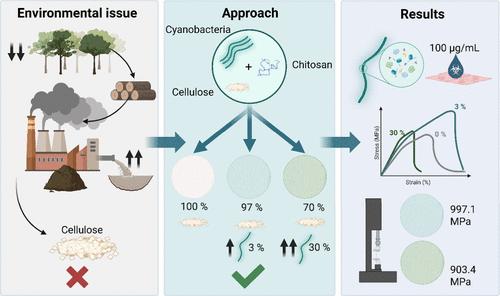Mechanical Reinforcement of Paper Biocomposites Using Filamentous Cyanobacteria
IF 7.3
1区 化学
Q1 CHEMISTRY, MULTIDISCIPLINARY
引用次数: 0
Abstract
Rising concerns over plastic packaging and the growing demand for e-commerce have increased paper-based materials production, thereby intensifying environmental impacts of the paper industry, one of the most polluting industries worldwide. The need to source nonwood fibers to alleviate environmental pressure has brought microalgae into the spotlight as a sustainable and renewable resource. For the first time, this study proposes and evaluates replacing cellulose fibers in paper-like biocomposites with the cyanobacterium Leptolyngbya sp. SB090721. The effect of using cyanobacteria as a cellulose replacement (0%, 3%, 30% w/w) was evaluated. Addition of cyanobacterial biomass (3–30%) maintained or enhanced tensile properties. The standard biocomposite showed the highest tensile strength (4.8 kN·m–1) and tensile energy absorption (195.63 J·m–2). Both the standard and high biomass composites showed enhanced elasticity moduli of 997.1 and 903.4 MPa. Significant structural differences were observed on the SEM micrographs, with the high biomass specimen displaying a distinct structure, attributed to its elevated cyanobacterial content. In conclusion, the study confirmed the feasibility of using unprocessed cyanobacterial biomass as a nonwood fiber source for paper and paperboard materials. This reduces the amount of cellulose used in the paper industry, offering new properties and production routes that could potentially be more sustainable.

利用丝状蓝藻对纸质生物复合材料进行机械加固
对塑料包装的日益关注和对电子商务需求的不断增长增加了纸质材料的生产,从而加剧了造纸业对环境的影响,造纸业是世界上污染最严重的行业之一。微藻作为一种可持续的可再生资源受到人们的关注,因为人们需要非木材纤维来缓解环境压力。本研究首次提出并评价了用蓝细菌SB090721代替纸状生物复合材料中的纤维素纤维。评估了使用蓝细菌作为纤维素替代品(0%,3%,30% w/w)的效果。添加蓝藻生物量(3-30%)保持或增强拉伸性能。标准生物复合材料的抗拉强度最高(4.8 kN·m-1),抗拉吸能最高(195.63 J·m-2)。标准和高生物量复合材料的弹性模量分别为997.1和903.4 MPa。在SEM显微照片上观察到显著的结构差异,高生物量标本显示出独特的结构,归因于其蓝藻含量的升高。综上所述,本研究证实了利用未经加工的蓝藻生物量作为纸和纸板材料的非木材纤维来源的可行性。这减少了造纸工业中纤维素的使用量,提供了可能更具可持续性的新特性和生产路线。
本文章由计算机程序翻译,如有差异,请以英文原文为准。
求助全文
约1分钟内获得全文
求助全文
来源期刊

ACS Sustainable Chemistry & Engineering
CHEMISTRY, MULTIDISCIPLINARY-ENGINEERING, CHEMICAL
CiteScore
13.80
自引率
4.80%
发文量
1470
审稿时长
1.7 months
期刊介绍:
ACS Sustainable Chemistry & Engineering is a prestigious weekly peer-reviewed scientific journal published by the American Chemical Society. Dedicated to advancing the principles of green chemistry and green engineering, it covers a wide array of research topics including green chemistry, green engineering, biomass, alternative energy, and life cycle assessment.
The journal welcomes submissions in various formats, including Letters, Articles, Features, and Perspectives (Reviews), that address the challenges of sustainability in the chemical enterprise and contribute to the advancement of sustainable practices. Join us in shaping the future of sustainable chemistry and engineering.
 求助内容:
求助内容: 应助结果提醒方式:
应助结果提醒方式:


